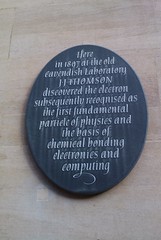Sir J. J. Thomson OM PRS FRS


Sir J. J. Thomson OM PRS FRS
(1856-1940)
Fellow of the Royal Society, Dalton Medal recipient, Nobel Physics Laureate (1906), Knight Bachelor (from 1908), Order of Merit recipient (from 1912), and 42nd President of the Royal Society (1915-1920)
Commemorated on 1 plaque
Here in 1897 at the old Cavendish Laboratory J. J. Thomson discovered the electron subsequently recognised as the first fundamental particle of physics and the basis of chemical bonding electronics and computing
Free School Lane, Cambridge, United Kingdom where they discovered the electron

